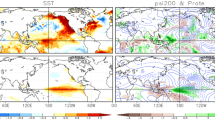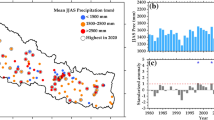Abstract
Previous studies suggest that North Pacific extratropical atmospheric variability influences ENSO via the seasonal footprinting mechanism (SFM). This study confirms that quadrapole sea surface temperature (SST) variability in the extratropical South Pacific triggered by mid-latitude South Pacific atmospheric variability may also have an additional influence on ENSO. The response of the evolution of the ENSO-related zonal wind and SST anomalies in the tropics to the South Pacific extratropical forcing is consistent with the SFM hypothesis. That is, the Pacific–South American (PSA) pattern of the South Pacific extratropical sea level pressure (SLP) anomalies imparts an SST footprint (i.e., a quadrapole SST pattern) onto the ocean during austral summer. This SST footprint subsequently forces the zonal wind anomalies along the equator in the following austral winter that ultimately result in ENSO events during the following austral summer via ocean–atmosphere coupling in the tropics. The present study demonstrates that the influences of extratropical atmospheric variability in the South Pacific and North Pacific on ENSO are different and relatively independent. It is possible that they may, together or separately, influence the occurrence of ENSO events, and the importance of the South Pacific forcing in initiating ENSO events is comparable with that of the North Pacific forcing. An empirical model was established to predict the Niño3.4 index based on the combined South Pacific and North Pacific signals, and results show that it can be used to produce skillful forecasts of the Niño3.4 index with a leading time of up to 1 year.













Similar content being viewed by others
References
Alexander MA, Vimont DJ, Chang P, Scott JD (2010) The impact of extratropical atmospheric variability on ENSO: testing the seasonal footprinting mechanism using coupled model experiments. J Clim 23:2885–2901
Ashok K, Behera SK, Rao SA, Weng H, Yamagata T (2007) El Niño Modoki and its possible teleconnection. J Geophys Res 112:C11007. doi:10.1029/2006JC003798
Ballester J, Rodríguez-Arias MÀ, Rodó X (2011) A new extratropical tracer describing the role of the western Pacific in the onset of El Niño: implications for ENSO understanding and forecasting. J Clim 24:1425–1437
Bond NA, Overland JE, Spillane M, Stabeno P (2003) Recent shifts in the state of the North Pacific. Geophys Res Lett 30:2183. doi:10.1029/2003GL018597
Bretherton CS, Smith C, Wallace JM (1992) An intercomparison of methods for finding coupled patterns in climate data. J Clim 5:541–560
Carril AF, Navarra A (2001) Low-frequency variability of the Antarctic circumpolar wave. Geophys Res Lett 28:4623–4626
Carton JA, Giese BS (2008) A reanalysis of ocean climate using Simple Ocean Data Assimilation (SODA). Mon Wea Rev 136:2999–3017
Chang P, Zhang L, Saravanan R, Vimont DJ, Chiang JCH, Ji L, Seidel H, Tippett MK (2007) Pacific meridional mode and El Niño-Southern Oscillation. Geophys Res Lett 34:L16608. doi:10.1029/2007GL030302
Chiang J, Vimont D (2004) Analogous Pacific and Atlantic meridional modes of tropical atmosphere–ocean variability. J Clim 17:4143–4158
Ding QH, Steig EJ, Battisti DS, Wallace JM (2012) Influence of the tropics on the southern annular mode. J Clim 25:6330–6348
Fogt R, Bromwich D (2006) Decadal variability of the ENSO teleconnection to the high-latitude South Pacific governed by coupling with the southern annular mode. J Clim 19:979–997
Gong DY, Wang SW (1999) Definition of Antarctic oscillation index. Geophys Res Lett 26:459–462
Grassi B, Redaelli G, Visconti G (2005) Simulation of Polar Antarctic trends: influence of tropical SST. Geophys Res Lett 32:L23806. doi:10.1029/2005GL023804
Harrison DE, Larkin NK (1998) El Niño-Southern Oscillation sea surface temperature and wind anomalies, 1946–1993. Rev Geophys 36:353–400
Holbrook NJ, Bindoff NL (1997) Interannual and decadal temperature variability in the southwest Pacific Ocean between 1955 and 1988. J Clim 10:1035–1049
Jin FF, An SI (1999) Thermocline and zonal advection feedbacks within the equatorial ocean recharge oscillator model for ENSO. Geophys Res Lett 26:2989–2992
Jin D, Kirtman BP (2009) Why the Southern Hemisphere ENSO responses lead ENSO? J Geophys Res 114:D23101. doi:10.1029/2009JD012657
Kalnay E et al (1996) The NCEP–NCAR 40-Year Reanalysis Project. Bull Am Meteor Soc 77:437–471
Kao HY, Yu JY (2009) Contrasting eastern Pacific and central Pacific types of ENSO. J Clim 22:615–632
Karoly DJ (1989) Southern Hemisphere circulation features associated with El Niño-Southern Oscillation events. J Clim 2:1239–1252
Kidson JW, Renwick JA (2002) The southern hemisphere evolution of ENSO during 1981–99. J Clim 15:847–863
Kug JS, Jin FF, An SI (2009) Two types of El Niño events: cold tongue El Niño and warm pool El Niño. J Clim 22:1499–1515
Kwok R, Comiso JC (2002) Southern ocean climate and sea ice anomalies associated with the southern oscillation. J Clim 15:487–501
L’Heureux ML, Thompson DWJ (2006) Observed relationships between the El Niño—Southern Oscillation and the extratropical zonal-mean circulation. J Clim 19:276–287
Larkin NK, Harrison DE (2005) Global seasonal temperature and precipitation anomalies during El Niño autumn and winter. Geophys Res Lett 32:L16705. doi:10.1029/2005GL022860
Li Y, Li JP, Feng J (2012) A teleconnection between the reduction of rainfall in southwest Western Australia and north China. J Clim 25:8444–8461
Li G, Li CY, Tan YK, Pan J (2013a) Impacts of the central and eastern Pacific types of ENSO on sea surface temperature in the South Pacific. Theor Appl Climatol 114:315–327
Li XF, Yu JJ, Li Y (2013b) Recent summer rainfall increase and surface cooling over Northern Australia: a response to warming in the tropical Western Pacific. J Clim 26:7221–7239
Mo KC (2000) Relationships between low-frequency variability in the Southern Hemisphere and sea surface temperature anomalies. J Clim 13:3599–3610
Mo KC, Higgins RW (1998) The Pacific-South American modes and tropical convection during the Southern Hemisphere winter. Mon Wea Rev 126:1581–1596
Montegut CD, Madec G, Fischer AS, Lazar A, Iudicone D (2004) Mixed layer depth over the global ocean: an examination of profile data and a profile-base climatology. J Geophys Res Oceans 109:C12003. doi:10.1029/2004JC002378
Newman M, Compo GP, Alexander MA (2003) ENSO-forced variability of the Pacific decadal oscillation. J Clim 16:3853–3857
North GR, Bell TL, Cahalan RF, Moeng FJ (1982) Sampling errors in the estimation of empirical orthogonal function. Mon Wea Rev 110:699–706
Picaut J, Masia F, du Penhoat Y (1997) An advective-reflective conceptual model for the oscillatory nature of the ENSO. Science 277:663–666
Pyper BJ, Peterman RM (1998) Comparison of methods to account for autocorrelation in correlation analyses of fish data. Can J Fish Aquat Sci 55:2127–2140
Rayner NA, Brohan P, Parker DE, Folland CK, Kennedy JJ, Vanicek M, Ansell T, Tett SFB (2006) Improved analyses of changes and uncertainties in sea surface temperature measured in situ since the mid-nineteenth century: the HadSST2 dataset. J Clim 19:446–469
Ribera P, Mann ME (2003) ENSO related variability in the Southern Hemisphere, 1948–2000. Geophys Res Lett 30:1006. doi:10.1029/2002GL015818
Rogers JC (1981) The North Pacific oscillation. J Climatol 1:39–57
Schneider N, Cornuelle B (2005) The forcing of the Pacific decadal oscillation. J Clim 18:4355–4373
Simmonds I, Jacka TH (1995) Relationships between the interannual variability of Antarctic sea-ice and the Southern Oscillation. J Clim 8:637–647
Terray P (2011) Southern Hemisphere extra-tropical forcing: a new paradigm for El Niño—Southern Oscillation. Clim Dyn 36:2171–2199
Thompson DWJ, Wallace JM (2000) Annular modes in the extratropical circulation. PartI: month-to-month variability. J Clim 13:1000–1016
Toniazzo T (2010) Climate variability in the south-eastern tropical Pacific and its relation with ENSO: a GCM study. Clim Dyn 34:1093–1114
Trenberth KE, Stepaniak DP (2001) Indices of El Niño evolution. J Clim 14:1697–1701
Vimont DJ, Battisti DS, Hirst AC (2001) Footprinting: a seasonal connection between the tropics and mid-latitudes. Geophys Res Lett 28:3923–3926
Vimont DJ, Wallace JM, Battisti DS (2003a) The seasonal footprinting mechanism in the Pacific: implications for ENSO. J Clim 16:2668–2675
Vimont DJ, Battisti DS, Hirst AC (2003b) The seasonal footprinting mechanism in the CSIRO general circulation models. J Clim 16:2653–2667
Walker GT, Bliss EW (1932) World weather V. Mem Roy Meteor Soc 4:53–84
Wang SY, L’Heureux M, Yoon JH (2013) Are greenhouse gases changing ENSO precursors in the western North Pacific? J Clim 26:6309–6322
White WB, Annis J (2004) Influence of the Antarctic circumpolar wave on El Nino and its multidecadal changes from 1950 to 2001. J Geophys Res 109: doi:10.1029/2002jc001666
White WB, Peterson RG (1996) An Antarctic circumpolar wave in surface pressure, wind, temperature and sea-ice extent. Nature 380:699–702
Xie SP, Philander SGH (1994) A coupled ocean–atmosphere model of relevance to the ITCZ in the eastern Pacific. Tellus 46A:340–350
Yu JY, Kim ST (2011) Relationships between extratropical sea level pressure variations and the central Pacific and eastern Pacific types of ENSO. J Clim 24:708–720
Yuan XJ, Martinson DG (2000) Antarctic sea ice extent variability and its global connectivity. J Clim 13:1697–1717
Zhang L, Chang P, Ji L (2009a) Linking the Pacific meridional mode to ENSO: coupled model analysis. J Clim 22:3488–3505
Zhang L, Chang P, Tippett MK (2009b) Linking the Pacific meridional mode to ENSO: utilization of a noise filter. J Clim 22:905–922
Zhang HH, Clement A, Di Nezio P (2014a) The South Pacific meridional mode: a mechanism for ENSO-like variability. J Clim 27:769–783
Zhang HH, Deser C, Clement A, Tomas R (2014b) Equatorial signatures of the Pacific Meridional Modes: dependence on mean climate state. Geophys Res Lett 41:2. doi:10.1002/2013GL058842
Acknowledgments
This research was jointly supported by the 973 project of China (2012CB955200), the National Natural Science Foundation of China (41175069), the China Special Fund for Meteorological Research in the Public Interest (GYHY201306031), and the Strategic Priority Research Program of the Chinese Academy of Sciences (XDA11010303).
Author information
Authors and Affiliations
Corresponding author
Rights and permissions
About this article
Cite this article
Ding, R., Li, J. & Tseng, Yh. The impact of South Pacific extratropical forcing on ENSO and comparisons with the North Pacific. Clim Dyn 44, 2017–2034 (2015). https://doi.org/10.1007/s00382-014-2303-5
Received:
Accepted:
Published:
Issue Date:
DOI: https://doi.org/10.1007/s00382-014-2303-5




